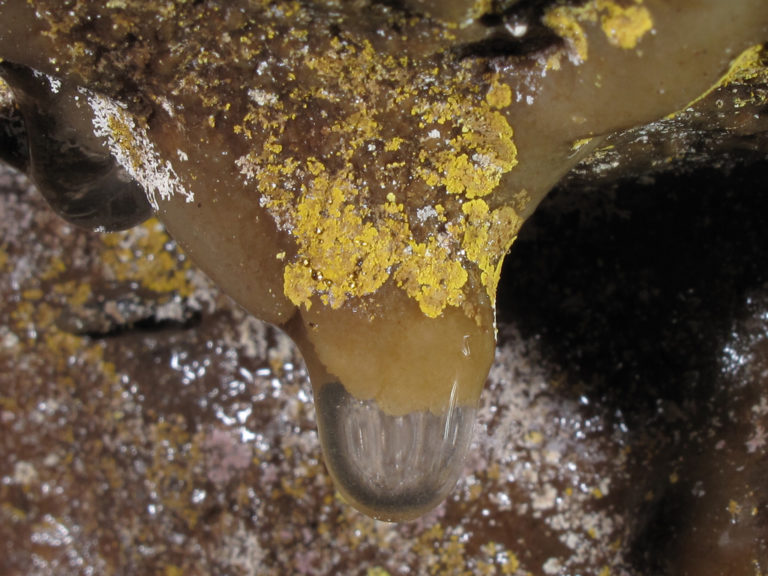Published January 9, 2019 | By Mike Petersen
Image above: actinomycetes in a large colony
Here it is winter, January 2019 in the Northern Hemisphere, soil microbes are either asleep or dormant in most soils below the 41 degree Fahrenheit point. I want to scratch at your brains to consider some of the biological importance of aerobes and anaerobes; whether they are cyanobacteria, fungi, nitrogen consumers, phosphate or potassium decomposers, or sulfur digesting workers in high residue environments.
When high carbon to nitrogen ratio (C:N) grown crops [corn and small grains with ratios of 45:1 up to 80:1] are in long term crop rotations with conservation tillage practices, we in Agriculture see Total N fraction (TN) of the soil generally improve up with proper N fertilization. All that is to say as you add forms of nitrogen into each years cropping system; both the fungal biomass and microbial biomass increase proportionately up. Some may say with a resounding duh. Well stay with me for a moment. In long term studies some over-the-pond researchers concluded a 23 year study of small grain rotations, they studied to determine which enzymes and/or organic reagents derived from the microscopic world tell you how Total Nitrogen and stable macroaggregates (those >2mm in size) can continue to climb in percent of the sand-silt-clay-SOM fraction. All of these stable aggregates relate to improved soil health.
When this happens your soils are more healthy, less erosive to water and wind erosion and will have more sites to hold nutrients. From that 23 year study the scientists found the fungal and fungi-like populations such as Actinobacteria made up of in the order of abundance in soils, the common genera of actinomycetes are: Streptomycetes (nearly 70%), Nocardia and Micromonospora with Actinomycetes, Actinoplanes, Micromonospora and Streptosporangium being 15%. All of these one celled creatures are involved in the breakdown of cellulose, chitin, lignin, fats, lipids, and some proteins from the remaining crop residues and roots. Some of who I just mentioned are anaerobic and do better in more moist No-Till environments compared to aerobic conditions where more tillage is involved. These organic compounds [N-acetyl-β-D-glucosaminidase, β-glucosidase, Phosphatase and Sulfatase] are some of the major components released by fungal populations and Actinobacteria to breakdown the cellulosic materials and tough lignin materials. All four of those compounds are released from higher populations of the fungi and Actinobacteria to aid in storage of N and stabilizing of carbon on the macroaggregates.
Wow that was a mouthful of large graduate school level microbiologic words that mean what? These one celled microbes with flagella or whip-like tails [Actinobacteria] facilitate movement in the soil solution and to move around on root surfaces. They are very good at breaking down complex cellulosic matter and making the N as an plant available component of those soil organic carbon materials, readily available to the existing crop/plant or subsequent plants. However they are mostly anaerobic or facultative anaerobic based, [live in low oxygen soil environments] which is not a good season long environment for roots and root respiration. These bacteria that act similar to fungi are important but some of them are pathogenic too. They can cause root rots, be precursors to fungal pathogens, pink root issues, dampening off and a host of other things. Soils that may be overly compacted, shallow water table, ponded, slow to very slow internal drainage in the first 24 inches, all can turn bad in a short period and create untold problems due to the wrong microbial families that take over. However, Actinobacteria are important in the soil ecology to break down carbon based materials into valuable components for plant and soil life.
What does this have to do with Precision Tillage, Strip-Tillage and you? For you that ever had to deal with wet soil conditions this spring, summer and fall – I wanted you to be aware of such conditions can exist and who is lurking under the corn leaves, stalks, and cobs. Strip-Tillage may fit into your 2019 management program. For you that have compaction due to harvest traffic that created ruts, smeared soils and holes where you took four hours to get the grain cart out of the field; soil conditions that squeezed oxygen out of the soil – issues I spoke of are happening and strip-tillage has a place. Now this is not all bad ladies and gents. Soils need to have a mix of all the aerobes, facultative anaerobes, anaerobes to enrich the spectrum of making nutrients available. Too many of the anaerobic miniature critters and we can see way too many negatives.
I will go into some more of the good miniature creatures in a subsequent blog article. Thanks for reading.
References I used and may serve your further reading:
Functional Predictions of Microbial Communities in Soil as Affected by Long-term Tillage Practices
Janani Hariharan, Aditi Sengupta, Parwinder Grewal, and Warren A. Dick*, Agricultural &
Environmental Letters, Research Letter published via ResearchGate on-line
Long-term effects of nitrogen fertilization on aggregation and localization of carbon, nitrogen and microbial activities in soil; YidongWang a,b, Zhong-LiangWang a,b,⁎, Qingzhong Zhang c, NingHud, ZhongfangLi d, Yilai Lou c,⁎⁎, Yong Li a,b, Dongmei Xue a,b, Yi Chene, ChunyanWue, Chris B. Zou a,f, Yakov Kuzyakov a,g; Science of the Total Environment Journal homepage: www.elsevier.com/locate/scitotenv
Growth of saprotrophic fungi and bacteria in soil, Johannes Rousk1,2 & Erland Baath 1, Microbiology Ecology
Mike Petersen
